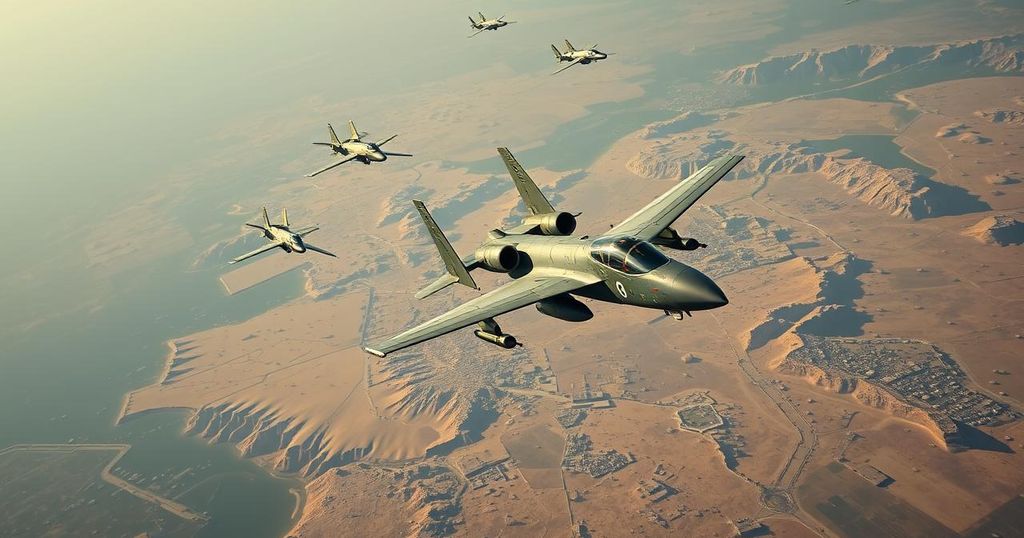U.S. B-2 Bombers Conduct Strikes Against Houthi Targets in Yemen

The United States conducted airstrikes against Iran-backed Houthis in Yemen using B-2 bombers, targeting underground weapon storage facilities. Defense Secretary Lloyd Austin indicated the strikes were authorized to weaken Houthi military capabilities following persistent attacks on U.S. and allied vessels. This operation, marking the first use of the B-2 against the Houthis, underscores the U.S. commitment to counteracting regional threats amidst escalating conflicts involving Iran, Israel, and allied forces.
On Wednesday evening, the United States executed a series of airstrikes in Yemen, specifically targeting the Iran-backed Houthi movement. Defense Secretary Lloyd Austin confirmed that the operation involved the use of B-2 stealth bombers to strike five underground facilities used for storing advanced conventional weaponry. These facilities were reportedly utilized to launch attacks against both military and civilian vessels within the Red Sea and the Gulf of Aden. In a statement, Austin remarked, “This was a unique demonstration of the United States’ ability to target facilities that our adversaries seek to keep out of reach, no matter how deeply buried underground, hardened, or fortified.” He emphasized that the deployment of B-2 bombers showcases U.S. global strike capabilities, asserting the nation’s commitment to act against such threats as necessary, anywhere and anytime. This marked the inaugural utilization of the B-2 Spirit long-range stealth bomber in strikes against the Houthis since the commencement of the U.S. military campaign in the region. The B-2, known for its larger payload capacity compared to previously used fighter jets, is adept at delivering a heavier bombardment. Austin indicated that the strikes were authorized at the request of President Joe Biden, aimed to “further degrade” the Houthis’ military capabilities following a year characterized by continuous Houthi strikes against U.S. and allied vessels. He noted that the targeted facilities contained various components used for weaponry employed against maritime targets in the Middle East. “We will continue to make clear to the Houthis that there will be consequences for their illegal and reckless attacks,” stated Austin. These developments occur amidst escalating tensions in the Middle East, where Israel is reportedly poised to retaliate against Iran for recent missile attacks, and ongoing conflicts with groups such as Hezbollah and Hamas. The Wednesday strikes represent a continuation of the reciprocal hostilities between the U.S. and the Houthis, who have persisted in their attacks on international shipping and military assets in the region. While previous operations involving strikes against the Houthis had been carried out in collaboration with the United Kingdom, this operation was singularly conducted by U.S. forces. U.S. Central Command reported that the strike incorporated both Air Force and Navy resources. Recent months have seen the U.S. intensifying its military actions against the Houthis, which included intercepting drone and missile threats aimed at protecting commercial shipping and diminishing the group’s military stockpile. Even in light of these efforts, the Houthis have continued their aggressive stance, with reports indicating over a dozen missile and drone launches directed at U.S. naval vessels without causing any damage or casualties among U.S. personnel. In earlier actions, the U.S. targeted Houthi military assets, stating the group had performed actions in support of other factions, specifically Hamas and Hezbollah. This relationship has facilitated ongoing hostilities, leading to the U.S. and Israel targeting Houthi installations in response to persistent threats posed by the group against regional stability. The persistence of Houthi attacks on commercial shipping has resulted in the loss of lives as well as significant environmental degradation. The Pentagon has cautioned against potential ecological catastrophes following various assaults on vessels, illustrating the broader repercussions of the conflict in the region.
The U.S. has been engaged in military operations against the Houthi movement in Yemen, a group supported by Iran. The Houthis have been involved in aggressive military actions in the region, targeting not only Yemeni forces but also international shipping and U.S. military vessels. The attacks along the Red Sea and Gulf of Aden have raised international concerns regarding maritime security, warranting U.S. military responses. This recent operation, utilizing B-2 bombers, signifies an escalation in U.S. military strategy, aimed at undermining the Houthis’ military capabilities and reinforcing the commitment to protect international shipping from ongoing Houthi aggression.
The U.S. airstrikes against Houthi targets in Yemen represent a significant evolution in military engagement strategies intended to assert control and maintain maritime security in the region. With the deployment of advanced weaponry like the B-2 bombers, the United States underscores its resolve to deter threats posed by the Iran-backed Houthis and protect allied vessels. These actions occur in a broader context of regional tensions, involving multiple actors and complex geopolitical dynamics.
Original Source: www.cnn.com








